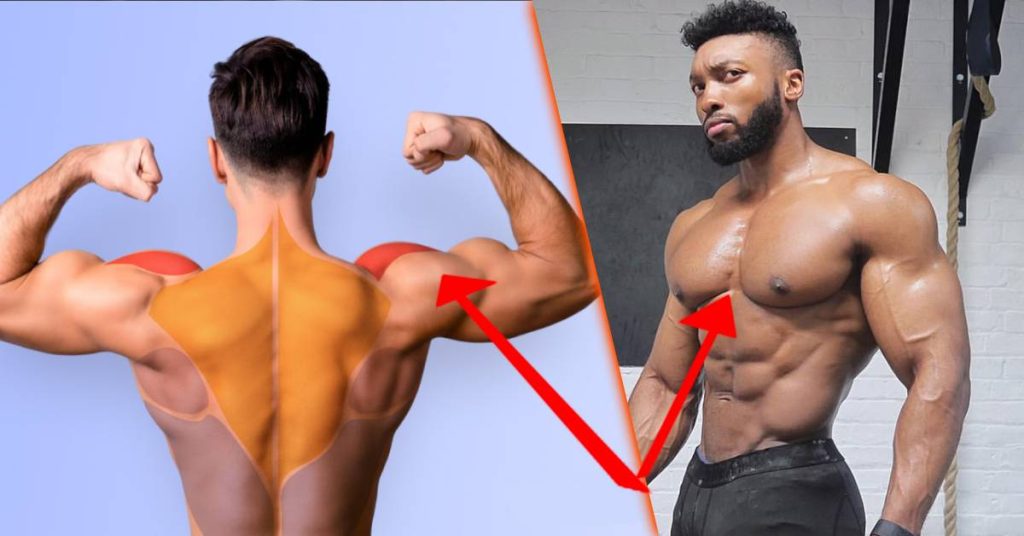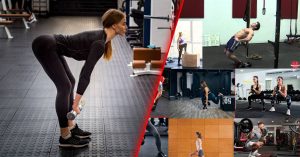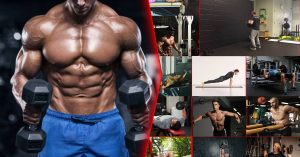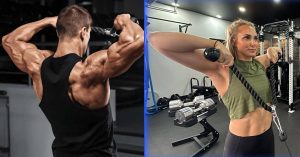Did you know that combining chest and shoulder workout can lead to explosive muscle growth and strength? This guide unveils the secrets! Imagine having a chest so broad and shoulders so powerful that you turn heads wherever you go. This isn’t just a dream; it’s a reality waiting for you on the other side of this workout routine.
The quest for a powerful chest and broad shoulders is not just about looks; it’s about building functional strength and confidence. This article dives deep into the “chest and shoulder workout,” a routine that has gained popularity for its effectiveness. But what makes it the best chest and shoulder workout? Let’s find out.
Table of contents
MORE keyboard_double_arrow_down LESS keyboard_double_arrow_up
The Science Behind Chest and Shoulder Workouts
For years, fitness enthusiasts have debated the perfect workout routine. Yet, the combination of chest and shoulder exercises stands out. These workouts not only enhance muscle symmetry but also improve posture and strength. What’s the science behind this powerful duo? Let’s take a look.
The chest or pectoral muscles consist of the pectoralis major and pectoralis minor. These muscles are crucial for pushing movements. On the other hand, the shoulders, encompassing the deltoids and rotator cuff muscles, are key for a wide range of motions.
Chest and shoulder workouts offer mutual benefits, enhancing each other’s effectiveness. Properly executed workouts improve posture and overall body strength.
For example, compound exercises like the bench press and overhead press work multiple muscle groups simultaneously.These exercises are known for their ability to stimulate explosive muscle growth.
Chest and Shoulder Exercises
When you mix chest and shoulder exercises, you get a powerful combo that builds strength and muscle. Let’s dive into some key exercises:
- Bench Press (Flat): Great for the whole chest.
- Incline Bench Press: Targets the upper chest.
- Overhead Press: Builds strong shoulders.
- Cable Fly: Shapes the chest.
- 1-Arm Cable Lateral Raise: Focuses on the shoulder’s side part.
Chest and shoulder workouts work well together because they help each other out. The shoulder muscles assist in many chest exercises. But, hitting your shoulders directly is key for balanced muscle growth. This is because some shoulder parts don’t get enough work from just chest exercises.
So, why not just do bench presses and call it a day? Well, if you want all-around shoulder strength and bigger muscles, you need to mix it up.
I have two special workouts for you. One boosts your pushing power with heavy lifts. The other one makes your muscles grow with a variety of moves. Each workout has its own focus but together, they cover all bases for muscle size and strength.
Workout 1: Horizontal Strength Mastery
This workout is all about pushing power from a horizontal perspective. Here’s how to do it:
- Barbell Bench Press (Flat): Start with 4 to 6 reps at an effort level of 7 out of 10, for 2 to 3 sets. This foundational exercise targets your chest, shoulders, and triceps.
- Overhead Press: Move on to 5-8 reps, keeping the effort level at 7. This works your shoulders and upper chest.
- High Incline Dumbbell Bench Press: Aim for 8 to 12 reps at an effort level of 7-8. The incline angle targets your upper chest and shoulders.
- Single Arm Cable Lateral Raise: Finish with 10 to 15 reps at an effort level of 8-9, focusing on the shoulders.
Workout 2: Vertical Strength Focus
Now, let’s shift the focus vertically for a well-rounded approach:
- Overhead Press: Again, 4 to 6 reps at an effort level of 7, focusing on shoulder power.
- Barbell Bench Press: Follow up with 5-8 reps at the same effort level, targeting your chest and triceps.
- Low Incline Dumbbell Bench Press: 8 to 12 reps at an effort level of 7-8, hitting the upper chest.
- Cable Flyes: End with 10 to 15 reps at an effort level of 8-9 for chest definition.
How often should you do these workouts? It depends on your goals, fitness level, and what muscle groups you’re focusing on. Listen to your body and adjust accordingly.
Bench Press (Flat)
The bench press is more than just lifting weights; it’s a technique-driven move that boosts strength and size. Here’s your step-by-step guide:
- Lie on the bench, eyes under the bar, feet flat on the ground. Keep your back, head, and hips on the bench.
- Grip hands just wider than shoulder-width, wrap thumbs around the bar.
- Unrack the bar with straight arms, bringing it to the starting position above your chest.
- Inhale, lower the bar to your mid-chest. Exhale, push the bar up and slightly back.
- Perform your reps, then safely rack the bar.
Remember, it’s not just about lifting heavy; it’s about lifting right.
The Overhead Press
The overhead press, or military press, is a fundamental move targeting your upper body’s powerhouse muscles. Here’s how to get it right:
- Aim for 2 to 4 sets of 6-10 reps, keeping the intensity at an RPE (Rate of Perceived Exertion) of 7-8.
- It works your pecs, deltoids, triceps, and even your trapezius. More than just lifting, it’s about engaging and growing these muscles.
- Dumbbells are preferred for their ability to better activate your shoulder muscles, though barbells and machines are also effective.
Here’s how to perform it:
- Stand (or sit for less core engagement) with your back straight, holding a dumbbell in each hand at shoulder level.
- Exhale as you press the weights overhead, then inhale as you return to the start. Keep your grip firm but not tight.
The Cable Flye
Cable flyes excel in isolating and sculpting the chest and shoulders. Here’s how to maximize their potential:
- Go for 3 to 4 sets of 10-15 reps, targeting an RPE of 8 to 9.
- This move zeroes in on the pectoralis major and the anterior deltoid, perfect for those seeking hypertrophy without heavy loading.
- A cable machine and the correct handle placement are crucial for this exercise’s success.
Here’s how you can perform it:
- Adjust the cables to just above shoulder height and stand facing away from the machine, handles in hand.
- With a slight bend in your elbows, draw the handles together in a wide arc. Focus on using your chest muscles to perform the work, keeping your core engaged.
Both the overhead press and the cable flye are more than just movements; they’re about building a balanced, strong physique. With the overhead press, you get a compound exercise that builds functional strength across multiple muscle groups.
The cable flye, on the other hand, allows for targeted muscle sculpting, providing a complementary balance to your workout routine.
1-Arm Cable Lateral Raise
Transform your shoulder workouts with the 1-Arm Cable Lateral Raise, a key exercise for enhancing shoulder definition and strength. Here’s how to incorporate this targeted move into your routine for maximum effect:
- Aim for 3 to 4 sets of 10-15 repetitions, adjusting the weight to be challenging but doable within this range.
- Choose a weight that brings you to within 1 to 2 reps of failure, ideally at an RPE (Rate of Perceived Exertion) of 8 to 9.
- This exercise zeroes in on the medial deltoid, crucial for that sought-after shoulder width and definition.
Benefits of 1-Arm Cable Lateral Raise are as follows:
The 1-Arm Cable Lateral Raise isn’t just about aesthetics; it’s a functional exercise that strengthens the shoulder, including the rotator cuff muscles, enhancing both appearance and mobility.
- By isolating the medial deltoid, you ensure focused development and strengthening of this key shoulder area.
- Research highlights its benefits for the infraspinatus and subscapularis muscles, aiding in smoother shoulder rotations.
Here is how you can successfully perform this exercise:
- Opt for a manageable weight. This exercise emphasizes control and precision over sheer load.
- Stand next to the cable machine, feet shoulder-width apart. Engage your core and ensure your chest is up and shoulders are back.
- Holding the cable attachment, raise your arm to the side, keeping a slight bend in your elbow to target the medial deltoid effectively. Avoid locking your elbow or rotating your arm during the lift.
- Smoothly lift the weight to shoulder height, maintaining tension on the deltoid. Pause briefly at the top before slowly lowering back to the starting position.
Tips for Success
- Prioritize maintaining proper form over lifting heavier weights to maximize gains and minimize injury risk.
- Focus on the medial deltoid throughout the exercise to ensure it’s doing the work.
- Regular incorporation of this exercise into your routine will lead to noticeable improvements in shoulder shape and strength.
Understanding the Chest and Shoulder Anatomy
Understanding the anatomy of the chest and shoulders is crucial for effective strength training and injury prevention. Let’s break down the complex structures that power your upper body movements.
The Shoulder Girdle
The shoulder is a marvel of engineering, comprising four main joints and a network of muscles that allow for an incredible range of motion. Here’s a closer look:
Joints Involved:
- Glenohumeral (GH) Joint: The ball and socket connection between the arm and torso.
- Acromioclavicular (AC) Joint: Links the collarbone to the shoulder blade.
- Sternoclavicular (SC) Joint: Attaches the collarbone to the sternum.
- Scapulothoracic (ST) Joint: A functional joint where the shoulder blade glides over the back.
Together, these components enable the shoulder to move freely and perform complex tasks.
Chest Muscles
The chest is vital for pushing movements and overall upper body strength. Let’s delve into the key muscles:
- Pectoralis Major: This large muscle covers the upper chest and is responsible for pushing motions. It has two main parts:
- Clavicular Head: Originates from the collarbone.
- Sternocostal Head: Stems from the sternum and upper ribs.
- Pectoralis Minor: Located beneath the pectoralis major, this muscle aids in scapular movement.
- Serratus Anterior: This muscle fans out from the ribs to the scapula, playing a key role in shoulder stability.
- Subclavius: Situated under the collarbone, it helps in the downward movement of the shoulder.
Coordinated Movement: How It All Works Together
The chest and shoulder muscles collaborate to facilitate a range of motions, including:
- Internal Rotation: Turning the arm inward towards the body.
- Flexion and Extension: Moving the arm forward and backward.
- Protraction: Pushing the shoulder blade forward.
- Adduction: Drawing the arm towards the body’s midline.
This intricate system of muscles and joints allows for the dynamic movements necessary for everyday tasks and athletic performance.
By understanding the anatomy of your chest and shoulders, you can tailor your workouts to target these areas effectively, leading to improved strength, mobility, and injury prevention.
Training Chest Before Shoulders
Deciding whether to train chest before shoulders is a common dilemma. The consensus among fitness professionals leans towards starting with larger muscle groups, like the pecs, before moving on to smaller ones, like the shoulders. Here’s why.
Training larger muscles first maximizes your strength for these exercises because your energy levels are higher at the start of your workout. Furthermore, since shoulders assist in many chest exercises, pre-exhausting them could compromise your chest workout effectiveness.
However, if shoulder strengthening is your primary goal, flipping the order might work better for you, placing emphasis on shoulder exercises when you’re freshest.
Optimizing Muscle Development through Integrated Chest and Shoulder Training
Training chest and shoulders on the same day isn’t just practical—it’s also efficient. This is because most chest exercises engage the shoulders to some extent, making it challenging to isolate one completely from the other.
For well-rounded muscle growth, especially in terms of hypertrophy, incorporating specific exercises that target the shoulders on chest day ensures balanced development.
Ideal Workout Frequency For Shoulder and Chest Workout
How often should you train these muscle groups? While the goal is to stimulate growth without overtraining, here’s what to consider:
Aiming for at least two chest-focused workouts a week is a good start, but what about adding an extra day?
Research shows that the key factor in muscle development is not how often you train but the total volume of your workouts. Equal gains have been observed whether muscles are trained once or three times a week, as long as the total weekly volume remains consistent.
For example, take a look at this Instagram post by Krissy Cela a fitness trainer, where she carefully incorporates should and chest workouts into her workout routine:
Safety Precautions to Adhere in Chest and Shoulder Workouts
Embarking on a chest and shoulder workout journey can dramatically enhance your physique and strength. However, prioritizing safety and tailoring your approach to your unique needs are crucial for effective and injury-free progress. Here’s how you can ensure a safe and productive workout regimen:
Tailoring Volume to the Individual
Your workout’s volume—how much you do—must align with your individual capacity and goals. Overloading your muscles beyond what they can recover from might hinder growth instead of helping it.
So, determine the right mix of exercises, sets, and reps that challenge you without leading to overtraining. And also, make sure to adjust your workout volume based on how your body responds, ensuring continuous growth without burnout.
Embracing Progressive Loading
Muscle growth and strength gains are fueled by progressively challenging your muscles. This concept, known as progressive overload, is not about making every workout harder but about adjusting your training as you grow stronger.
So, keep in mind to gradually increase the weights or reps to continuously challenge your muscles within your capability. Change your workout routine every few weeks to prevent plateaus and keep your muscles adapting.
Selecting Movements That Suit You
Choosing the right exercises is not a one-size-fits-all scenario. It’s essential to pick movements that not only target the desired muscle groups but also suit your body and preferences.
So, consider Incorporating exercises that you enjoy and that fit your fitness level and goals. Also, mix horizontal and vertical movements to engage your chest and shoulders from various angles for balanced development.
Prioritizing Recovery
Allowing your muscles to recuperate after intense workouts is as important as the training itself. Recovery prevents injury and ensures your muscles are ready for the next challenge.
So make sure to Include rest days, adequate sleep, and nutrition in your routine to support muscle repair and growth. Furthermore, replenishing fluids post-workout aids in recovery and overall health.
Consulting with Healthcare Providers
Before starting any new workout regimen, especially if you have pre-existing conditions or injuries, seeking advice from a healthcare provider is wise.
Ensure you’re medically cleared to take on the physical challenges of chest and shoulder workouts. A healthcare provider can offer valuable advice on how to safely engage in strength training given your specific health circumstances.
Incorporating these safety precautions into your chest and shoulder workout routine can lead to sustained progress, helping you build strength and muscle safely and effectively. Remember, the goal is not only to look better but to ensure longevity and wellness in your fitness journey.
A Nutritional Guide For Chest and Shoulder Growth
Building an impressive upper body isn’t just about relentless training; it’s equally about what you fuel your body with. Nutrition is a cornerstone in the development of a strong chest and broad shoulders. Here’s a tailored guide to the nutritional strategies that support muscle growth and strength.
Caloric Intake
The energy your body requires is directly influenced by your muscle mass, genetic makeup, and the intensity of your activities.
- General Guideline: Aim for approximately 25 to 35 calories per kilogram of your body weight daily, adjusting based on your training intensity and goals.
- Customized Planning: Use tools like the NIH BW Planner to fine-tune your energy intake, ensuring you’re in the right caloric balance for muscle growth or maintenance.
Protein
Protein is paramount for muscle repair and growth. The standard intake recommendation has been debated, especially for those in heavy training.
Research suggests aiming for 1.6 grams of protein per kilogram of body weight daily to maximize muscle and strength gains.
Incorporate high-quality proteins like eggs, chicken, fish, tofu, and Greek yogurt into your diet. Consider supplements like whey or pea protein to meet your daily targets.
Carbohydrates
Carbs play a vital role in fueling exercise and recovery, making them a crucial component of your diet.
Avoid very low carb diets, especially if you’re training hard. Aim for 3 to 5 grams of carbohydrates per kilogram of body weight per day.
Focus on wholesome sources such as fruits, vegetables, grains, and legumes to provide sustained energy and support recovery.
Fats
Fats are crucial for overall health and hormonal balance, which in turn affects muscle growth. A healthy fat intake ranges from 0.5 to 1.0 grams per kilogram of body weight, focusing on unsaturated sources.
Include foods rich in omega-3s and other unsaturated fats like nuts, seeds, avocados, and fatty fish to support overall health and muscle recovery.
Integrating Nutrition into Your Training Plan
Understanding and implementing these nutritional principles can significantly impact your chest and shoulder development. It’s about more than just eating; it’s about nourishing your body with the right balance of nutrients to support your training efforts and achieve your physique goals.
Remember, individual needs vary, and what works for one person may not work for another. Listen to your body, be willing to adjust your nutritional plan as you progress, and consider consulting with a nutrition professional to tailor a plan to your specific needs.
With the right approach to both training and nutrition, you’re setting the stage for substantial upper body gains.
Expert Insights on Balancing Your Routine
The combination of these exercises creates a synergistic effect that accelerates muscle growth. But what do experts say about balancing these workouts for optimal results? Surprisingly, the consensus among fitness gurus is clear: it’s not just about what exercises you do, but how you do them.
Top trainers emphasize the importance of balancing intensity and recovery. Furthermore, proper form not only maximizes effectiveness but also minimizes the risk of injury. Experts argue that the right form can significantly increase the efficacy of each exercise.
Final Thoughts and Takeaways
The chest and shoulder workout, when done right, can transform your physique and strength levels. Remember, the key lies in technique, order, and balance.
Embarking on this workout journey promises not just a transformation of your physique but also a new level of self-discipline and dedication.With the insights and strategies shared, you now have a blueprint for achieving your chest and shoulder goals.
Dive into the journey of mastering the chest and shoulder workouts with confidence, knowing you have the expert-backed strategies and insights to guide you. Remember, the path to success is paved with consistency, correct form, and a well-balanced routine. Are you ready to unlock your full potential and achieve the physique of your dreams?
Key Points
- Combining chest and shoulder workouts can lead to explosive muscle growth and strength, providing a broad and powerful upper body.
- The chest and shoulder workout routine is not just about aesthetics but also focuses on functional strength and confidence.
- The science behind chest and shoulder workouts lies in the mutual benefits of enhancing muscle symmetry, improving posture, and overall body strength.
- Compound exercises like bench press and overhead press stimulate explosive muscle growth, emphasizing the effectiveness of chest and shoulder workouts
- Key exercises for chest and shoulders include bench press, incline bench press, overhead press, cable fly, and 1-arm cable lateral raise.
- Two specialized workouts, Horizontal Strength Mastery and Vertical Strength Focus, offer different focuses but together cover all bases for muscle size and strength.
- Understanding the anatomy of the chest and shoulders is crucial for effective strength training, detailing the shoulder girdle and chest muscles.
- Safety precautions, including tailoring volume, embracing progressive loading, selecting suitable movements, prioritizing recovery, and consulting healthcare providers, ensure a safe and productive chest and shoulder workout routine.
FAQs
Can I Do Shoulder and Chest Workouts Together?
Yes, combining chest and shoulder workouts into a single upper body push workout is highly recommended by fitness professionals, including Juster and Meyer. This approach is beneficial because the shoulders assist in many chest movements, such as the bench press or dips. Training them on the same day can optimize your workout efficiency and effectiveness.
What Is the Best Chest and Shoulder Workout?
The Ultimate Chest and Shoulders Workout as recommended includes:
- Barbell Bench Press: 4-5 sets of 5-8 reps (rest 3 minutes between sets)
- Barbell Overhead Press: 3-4 sets of 6-8 reps (rest 3 minutes)
- Incline Bench Press: 3-4 sets of 8-12 reps (rest 2 minutes)
- Dumbbell Rear Delt Fly: 3-4 sets of 8-12 reps (rest 2 minutes)
- Chest Dips: 3-4 sets of 8-12 reps (rest 2 minutes)
This combination targets all the major muscles in the chest and shoulders, providing a comprehensive upper body workout.
Should I Train Shoulders or Chest First?
It’s generally better to train your chest before your shoulders. The rationale behind this sequence is that your shoulders are already engaged during many chest exercises.
Training your chest first ensures that you can maximize your performance in these exercises without the fatigue that might come from a prior shoulder workout. However, individual preferences and goals should guide your decision on the sequence of exercises.

ABOUT THE AUTHOR
Follow Valen Steven for a dose of fitness enthusiasm, evidence-based advice, and a roadmap to achieving your health and wellness goals.
Subscribe to our Newsletter
Dive into a world of fitness and wellness with our exclusive newsletter! Sign up now and receive weekly power-packs of fitness wisdom




